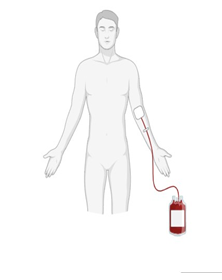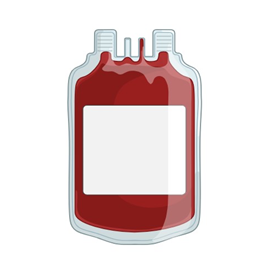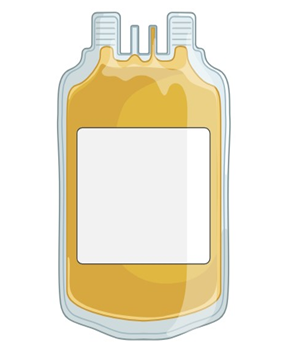Introduction
Blood donation is an essential component of contemporary medicine, a selfless gesture that saves countless lives and supports crucial medical operations ranging from life-saving surgeries to the treatment of chronic ailments.1 Every unit of donated blood signifies a possible story of recovery, a link between a stranger in need and a second opportunity. Blood is a complicated and irreplaceable fluid that transports oxygen, nutrients, and waste throughout the body. Unfortunately, the human body cannot easily store surplus blood. This necessitates a consistent supply to support the continuing needs of our organs and tissues. Blood transfusions are a lifeline in a variety of medical situations, including replenishing blood loss in accident victims and ensuring safe surgical environments, as well as providing regular transfusions to people with chronic blood disorders and cancer patients with suppressed bone marrow function. However, the demand for these life-saving transfusions has constantly outpaced the supply. This shortage is caused by two major factors: a) the limited shelf life of red blood cells, the primary component used (approximately 42 days), necessitating a constant stream of new donations; and b) eligibility restrictions based on medical conditions, medications, and travel history, which reduce the pool of potential donors. Blood donation is an act of tremendous social responsibility that allows individuals to actively contribute to the well-being of their communities while potentially saving lives. Despite the crucial need for blood donors, certain medical problems can cause complications during the donation process.2 Epilepsy is a neurological illness defined by recurring seizures. Many countries' current blood donation guidelines restrict people with epilepsy from donating. Blood transfusions are a lifeline in a variety of medical situations, including replenishing blood loss in accident victims and ensuring safe surgical environments, as well as providing regular transfusions to people with chronic blood disorders and cancer patients with suppressed bone marrow function. However, there is insufficient supply of these life-saving transfusions due to two major issues: a) red blood cells, which are the primary component used, have a short shelf life (about 42 days), necessitating constant donation; and b) medical conditions, medications, and travel history make it difficult for people to become donors. One such restriction applies to individuals with epilepsy due to concerns about seizure risk, particularly for those with uncontrolled seizures, which could pose a safety risk for both the donor and medical personnel fainting, as blood donation can cause vasovagal reactions, which may be slightly more common in individuals with epilepsy. However, no research has definitely connected blood donation to increased seizure risk in well-controlled epilepsy, prompting a rethinking of the rationale for these restrictions. Modern blood donation clinics prioritise safety through pre-donation screening and monitoring, and overly tight restrictions may unfairly disqualify qualified donors. We need to take a balanced approach to this complicated issue, prioritising both safety and inclusion. Here are some potential areas of advancement. Individualised assessments that consider factors such as seizure frequency and overall health will be used in future research to determine the true risk of seizures associated with donation in people with epilepsy, as well as updated guidelines for healthcare professionals' educational initiatives for both donors and medical personnel to foster a more informed and supportive environment. Finally, the goal should be a safe and welcoming blood donation system that allows people with well-controlled epilepsy to participate in this life-saving effort.3
Risks and Concerns
Blood donation serves as a cornerstone of modern medicine, a critical act that sustains countless lives. However, ensuring donor safety is paramount. One condition that raises concerns regarding blood donation is epilepsy, a neurological disorder characterised by recurrent seizures.4 This section delves into the specific risks and concerns associated with epilepsy and blood donation, along with the complexities of the current scientific evidence. The primary concern surrounding blood donation among individuals with epilepsy is the potential for a seizure to occur during the donation process. Seizures are episodes of abnormal electrical activity in the brain that can manifest in various ways, from brief lapses in consciousness to full-blown convulsions. In some people with epilepsy, there are several theoretical reasons why blood donation might trigger a seizure:
Stress and Anxiety: The process of blood donation can be stressful, involving needles, unfamiliar surroundings, and potential discomfort. Stress is a recognised trigger for seizures in some individuals with epilepsy.
Vasovagal Reaction: Donating blood can trigger a vasovagal reaction, a temporary drop in heart rate and blood pressure that can cause light-headedness and fainting. This reaction can mimic the aura (warning signs) experienced before some seizures, potentially leading to a true seizure.
Hypoglycaemia: Blood donation can lead to a slight drop in blood sugar levels, especially in individuals who haven't eaten properly before donation. Low blood sugar is another potential trigger for seizures in some people with epilepsy.
The severity of the potential consequences of a seizure during blood donation depends on several factors:
Seizure Type: Some types of seizures are more discreet (e.g., focal seizures with minimal awareness changes) and pose less risk of injury compared to generalised tonic-clonic seizures (grand mal seizures), which involve full-body convulsions and loss of consciousness.
Medical Supervision: Modern blood donation centres provide ongoing monitoring during the donation process. This allows medical personnel to identify early signs of distress and intervene if necessary.
Lack of Conclusive Scientific Evidence
Despite the theoretical concerns, current research findings on the relationship between blood donation and seizure risk in epilepsy are inconclusive. Here's a closer look at the limitations:
Limited Studies: Relatively few studies have specifically investigated this association. Existing research often involves small sample sizes or retrospective analyses, making it difficult to draw definitive conclusions.
Selection Bias: Studies may inadvertently exclude individuals with more severe epilepsy or those who are poorly controlled, potentially underestimating the true risk.
Confounding Factors: Many factors can influence seizure risk. Studies need to account for variables such as seizure type, medication adherence, and co-existing medical conditions to isolate the specific impact of blood donation.
Here are some key findings from existing research:
A 1992 study published in Transfusion Medicine Reviews found no significant difference in the rate of adverse events, including seizures, between blood donors with epilepsy and those without.
A 2000 study in Research Gate explored autologous blood donation (where a patient donates blood for their own future use) in individuals with epilepsy. The study found no instances of seizures triggered by the donation process.
However, these studies highlight the need for further investigation with larger, well-designed studies to definitively assess the potential risks associated with blood donation in people with epilepsy. The current narrative surrounding blood donation and epilepsy is ripe for change. Restrictive guidelines, often based on limited evidence, may unfairly exclude individuals with well-controlled epilepsy from donating:
A more nuanced approach involving individualised assessments that consider factors like seizure control and overall health could pave the way for safer and more inclusive blood donation practices.
Educational initiatives for both donors and medical personnel are also crucial in fostering a supportive environment for potential donors with epilepsy.
Ultimately, ensuring blood donation safety remains paramount, but ongoing research and a risk-benefit analysis can help us evolve the narrative around epilepsy and blood donation to benefit both donors and recipients.5
Variations in blood donation guidelines
The regulations regarding blood donation for epilepsy vary significantly. Some countries, like India, have a complete deferral, while others, like the US, allow donations after a period of seizure freedom. This inconsistency highlights the need for a more unified approach based on robust research and evidence-based guidelines.
Current regulations
The regulations on blood donation for epilepsy vary significantly across countries and organizations. This section provides an in-depth analysis of these variations, highlighting the complexities and opportunities for a more unified approach.6
Understanding Blood Donation Regulations
National health authorities or blood collection organizations such as the American Red Cross or the Australian Red Cross Blood Service establish blood donation regulations. These guidelines aim to ensure the safety of both the donor and the recipient of the blood. Here's a breakdown of the key considerations influencing blood donation regulations:
Medical Conditions: Certain medical conditions, including epilepsy, can pose potential risks during blood donation. Regulations outline restrictions for these conditions based on the perceived risk and available scientific evidence.7
Donor Medical History: Pre-donation screening processes gather information about an individual's medical history, medications, and lifestyle habits to assess their suitability for donation.8
Safety Measures: Blood donation centres implement various safety measures to ensure donor comfort and minimise potential risks. These may include pre-donation assessments, monitoring during the donation, and post-donation recovery measures.9
Variations in Epilepsy-Specific Guidelines
The current regulations concerning blood donation for individuals with epilepsy exhibit significant variations across the globe. Here's a glimpse into this complex landscape:Complete Deferral: Some countries, including India, Singapore, and many Middle Eastern nations, have a complete deferral10policy for individuals with any history of epilepsy, regardless of seizure control.
This approach prioritises complete safety but can significantly limit the donor pool.
Deferral Based on Seizure Control: Several countries, such as the United States and the United Kingdom, implement a deferral system based on seizure control. Individuals with a history of well-controlled epilepsy (no seizures for a specific period, typically 1-3 years) may be eligible to donate after undergoing a thorough pre-donation assessment by a physician.11$
3. Individualised Assessment: A few countries, including Canada and some European nations, are moving towards a more individualised approach. This involves detailed assessments that consider seizure type, frequency, medication adherence, and overall health status to determine eligibility for each donor with epilepsy on a case-by-case basis. 12
Factors Contributing to Variations
Several factors contribute to the discrepancies in blood donation regulations for epilepsy:
1. Level of Medical Evidence: The lack of conclusive scientific evidence regarding the true risk of seizures associated with blood donation in people with epilepsy makes it difficult to establish a universally accepted guideline. 13
2. Risk-Benefit Analysis: Different countries may weigh the potential risks of seizures against the critical need for blood differently, leading to variations in regulations. 14
3. Cultural Attitudes towards Epilepsy: The stigma surrounding epilepsy can influence policy decisions, with some countries being more cautious about potential risks. 15
Harmonization is needed.
The current patchwork of regulations creates several challenges:
1. Donor Confusion: Individuals with epilepsy may face inconsistent eligibility criteria depending on their location, leading to confusion and frustration. 16
2. Limited Blood Supply: The exclusion of potentially eligible donors with well-controlled epilepsy can exacerbate blood shortages in some regions. 17
3. Scientific Advancement: A lack of standardised regulations hinders further research into the safety of blood donation for individuals with epilepsy. 18
Moving to a More Unified Approach
There's a growing movement towards harmonising blood donation guidelines for epilepsy across different countries and organizations. Here are some potential strategies:
1. Collaborative Research: International research collaborations can generate more robust data on the risks associated with blood donation in epilepsy, informing evidence-based guidelines. 19
2. Global Standards: International organisations like the World Health Organisation (WHO) can work with national health authorities to develop evidence-based and standardised guidelines for blood donation eligibility, including those with epilepsy. 20
3. Sharing Best Practices: Countries with established protocols for blood donation in well-controlled epilepsy can share their experiences and successes to encourage other nations to adopt similar approaches. 21
The way forward
Ultimately, the goal is to establish regulations that prioritise donor safety while maximising the number of eligible donors, including those with well-controlled epilepsy. Striking this balance requires ongoing research, collaboration between international bodies, and a willingness to re-evaluate existing policies based on new evidence. 22
Brief Summary of Variations
Here's a quick table summarising the variations in blood donation guidelines for epilepsy patients across different countries and organisations:
Table 1
Potential Benefits of Allowing Donations
The current restrictions on blood donation for people with controlled epilepsy raise important questions about the potential benefits and impact on the donor pool. This section explores these considerations, highlighting the advantages of a more inclusive approach. Expanding blood donation eligibility to include individuals with well-controlled epilepsy offers a multitude of potential benefits. 23 First, it could significantly address the critical issue of blood shortages. A 2018 Transfusion Medicine Reviews study estimated that relaxing restrictions in the US alone could yield an additional 630,000 blood donations annually, potentially saving countless lives. Secondly, allowing these individuals to donate fosters a sense of inclusion and social responsibility, potentially leading to increased donor satisfaction and long-term commitment. This can be particularly empowering for people with epilepsy, a condition often shrouded in stigma. The act of donating showcases their health and positive contribution to society, potentially boosting self-esteem and challenging negative perceptions. 24 Finally, including individuals with controlled epilepsy in well-designed research studies can provide valuable data for establishing more evidence-based guidelines in the future. This advancement in research is critical, given the lack of conclusive evidence that currently hinders a more nuanced approach to blood donation eligibility for this population. However, it's important to acknowledge that these potential benefits require careful consideration, as well as the potential risks associated with seizures during donation. 25 Expanding blood donation eligibility to encompass individuals with controlled epilepsy holds the potential to significantly increase the donor pool. While estimates suggest epilepsy affects roughly 50 million people globally, not all would qualify. The focus should be on those with well-controlled epilepsy, defined as having no seizures for a set period (usually 1-3 years) while adhering to proper medication regimens. Individualised assessments that consider seizure type, frequency, medication adherence, and overall health can further refine eligibility criteria, maximising inclusion while prioritising safety. 26 Education programmes targeting healthcare professionals and people with epilepsy can effectively address concerns and promote active involvement. Nevertheless, the act of enlarging the group of potential donors requires a thoughtful examination of the obstacles involved. Thorough evaluations before donating are critical for identifying possible dangers, which can require further training for medical staff. Effective strategies for managing and providing support in the event of a seizure during a donation are critical for both the donor and the medical personnel's well-being. Effective communication strategies are essential for addressing concerns related to the inclusion of donors with controlled epilepsy. Maintaining public trust in blood safety is of utmost importance and requires careful consideration of the potential benefits in relation to the potential risks, such as a larger donor pool, increased donor satisfaction, and advancements in research. 27 Seizure severity, developments in seizure care, and safety procedures in blood donation centres are all factors that contribute to the assessment of risk. Striking a harmonious equilibrium between ensuring safety and promoting diversity is a moral obligation. To establish a more inclusive blood donation system, it is crucial to conduct ongoing research, maintain honest communication, and adhere to evidence-based rules.28 The Blood collected from the donors are converted to life saving components such as packed red blood cells, plasma and platelets.
Need for further research
While blood donation is vital, current restrictions on individuals with controlled epilepsy stem from concerns about potential seizures during the process. However, the lack of conclusive evidence in existing research, often limited by scope, selection bias, and confounding factors, hinders the development of balanced guidelines.29 Further research is crucial. Large-scale prospective studies, comparisons with healthy controls, and exploration of genetic markers can provide a clearer understanding of seizure risk, leading to refined eligibility criteria and improved public confidence. Additionally, advancements like wearable seizure monitoring technology can further enhance risk management. International collaboration through multicentre studies, standardised protocols, and .best practice sharing is key to accelerating progress.30 Ultimately, prioritising research, fostering collaboration, and implementing evidence-based guidelines can pave the way for a safe and inclusive blood donation system that embraces individuals with controlled epilepsy.
Conclusion
The potential benefits of expanding the donor pool by allowing individuals with controlled epilepsy to donate blood necessitate a commitment to further research. By conducting rigorous studies, collaborating on an international scale, and prioritising safety, we can develop a comprehensive understanding of the true risks associated with blood donation in this population. This knowledge can pave the way for evidence-based guidelines that maximise donor safety while broadening the pool of eligible donors and ultimately saving more lives through the selfless act of blood donation. The issue of blood donation and epilepsy is complex, requiring a multifaceted approach that prioritises safety while acknowledging the potential benefits of inclusion. Expanding the donor pool by allowing individuals with controlled epilepsy to donate blood could significantly impact the availability of this life-saving resource. By conducting further research, implementing robust safety measures, and fostering a culture of inclusivity, we can move towards a blood donation system that is both safe and equitable. This comprehensive exploration of blood donation and epilepsy has covered the importance of the practice, current restrictions for individuals with epilepsy, variations in regulations across the globe, the potential benefits of allowing donation, the need for further research, and the importance of international collaboration. By promoting a balanced approach that prioritises safety, inclusivity, and continuous research, we can ensure a sustainable and equitable blood donation system for the future.




